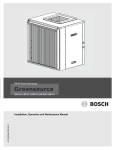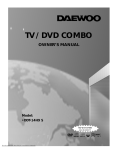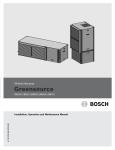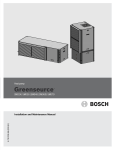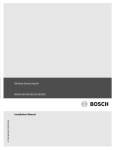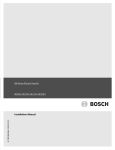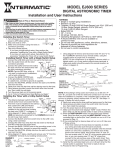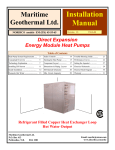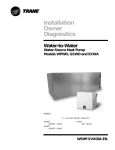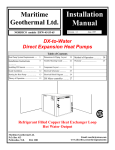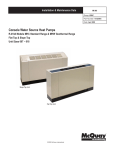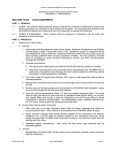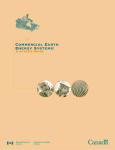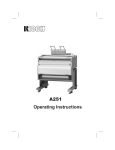Download Bosch SM048 Specifications
Transcript
SM CS Series Heat pump SM024 | SM036 | SM048 | SMO60 | SM070 8 733 920 846 (2014/01) Installation, Operation and Maintenance Manual 2| SM CS Series Heat Pump CONTENTS UNIT START-UP................................................................19 Model Nomenclature.......................................................... 3 Key to Symbols.................................................................. 3 Safety Warnings................................................................ 3 MAINTENANCE ................................................................20 UNIT CHECK-OUT SHEET ..................................................21 Standard SM CS package ................................................... 4 TROUBLESHOOTING ........................................................22 Unit Lockouts ............................................................25 GENERAL DESCRIPTION .................................................... 4 OPERATING TEMPERATURES AND PRESSURES .................26 MOVING AND STORAGE ..................................................... 4 WATER SIDE PRESSURE DROP TABLE ...............................31 INITIAL INSPECTION .......................................................... 4 WIRING DIAGRAMS..........................................................32 LOCATION......................................................................... 4 Condensing Section ..................................................... 4 Air Handler ................................................................. 5 DIMENSIONAL DRAWINGS ...............................................33 PIPING.............................................................................. 5 ELECTRICAL...................................................................... 6 Safety Devices and the UPM Controller ........................... 6 SPARE PARTS LIST...........................................................34 CS Parts List - Cabinet ................................................35 CS Parts List -Refrigeration/Electrical ...........................36 Notes ..............................................................................39 OPTIONS......................................................................... 10 Heat Recovery Package (HRP) ..................................... 10 DPS Water Flow Proving ............................................. 10 Pump Relay............................................................... 10 Comfort Alert Module ................................................. 10 HEAT RECOVERY PACKAGE ............................................. 11 Water Tank Preparation .............................................. 11 HR Water Piping ........................................................ 11 Water Tank Refill........................................................ 12 Initial Start-Up........................................................... 12 SEQUENCE OF OPERATION .............................................. 13 Cooling Mode ............................................................ 13 Heating Mode............................................................ 13 APPLICATION CONSIDERATIONS...................................... 15 Well Water Systems ................................................... 15 Cooling Tower/Boiler Systems ..................................... 16 Geothermal Systems .................................................. 18 SYSTEM CHECKOUT ........................................................ 19 Figure 1: CS/AH Pairings UNIT MODEL Unit 1 SM024-1CSC SM024-1AVX SM036-1CSC SM036-1AVX SM048-1CSC SM048-1AVX SM060-1CSC SM060-1AVX SM070-1CSC SM070-1AVX Paired Air Handler Unit 2 Unit 3 Unit 4 SM024-1AHX DX025-1VTX DX025-1CCX SM036-1AHX DX035-1VTX DX035-1CCX SM048-1AHX DX049-1VTX DX049-1CCX SM060-1AHX DX061-1VTX DX061-1CCX SM070-1AHX DX071-1VTX DX071-1CCX Unit 5 DX025-1UCX DX035-1UCX DX049-1UCX DX061-1UCX DX071-1UCX Unit 6 DX035-1VTX DX049-1VTX DX071-1VTX LEGEND: AVX BOSCH box style Vertical Air Handler AHX BOSCH box style Horizontal Air Handler CCX Cased coil UCX Uncased coil VTX BOSCH unitary style air handler 8 733 920 846 (2014/01) Subject to change without prior notice SM CS Series Heat Pump SM CS Series Heat Model Nomenclature | 3 MODEL NOMENCLATURE SM 024 - 1 CS C - F SERIES WATER CONNECTIONS SM F - Front SIZE COAX OPTIONS 024 036 048 060 070 C - Copper N - Cupro-Nickel CABINET CONFIGURATION CS - Condensing Section VOLTAGE DESIGNATIONS 1 - 208/1/60 & 230/1/60 Revision Level A KEY TO SYMBOLS Warnings Warnings in this document are identified by a warning triangle printed against a grey background. Keywords at the start of the warning indicate the type and seriousness of the ensuing risk if measures to prevent the risk are not taken. The following keywords are defined and can be used in this document: • NOTE indicates a situation that could result in damage to property or equipment. • CAUTION indicates a situation that could result in minor to medium injury. • WARNING indicates a situation that could result in sever injury or death. • DANGER indicates a situation that will result in severe injury or death. Important Information This symbol indicates important information where there is no risk to property or people. SAFETY WARNINGS Installation and servicing of this equipment can be hazardous due to system pressure and electrical components. Only trained and qualified personnel should install, repair, or service the equipment. Before performing service or maintenance operations on the system, turn off main power to the unit. Electrical shock could cause personal injury or death. All refrigerant discharged from this unit must be recovered WITHOUT EXCEPTION. Technicians must follow industry accepted guidelines and all local, state, and federal statutes for the recovery and disposal of refrigerants. If a compressor is removed from this unit, refrigerant circuit oil will remain in the compressor. To avoid leakage of compressor oil, refrigerant lines of the compressor must be sealed after it is removed. To avoid equipment damage, DO NOT use these units as a source of heating or cooling during the construction process. Doing so may affect the unit’s warranty. The mechanical components and filters will quickly become clogged with construction dirt and debris, which may cause system damage. Revised 01-14 8 733 920 846 (2014/01) 4 | Standard SM CS package SM CS Series Heat Pump STANDARD SM CS PACKAGE MOVING AND STORAGE If the equipment is not needed for immediate installation upon its arrival at the job site, it should be left in its shipping carton and stored in a clean, dry area. Units must only be stored or moved in the normal upright position as indicated by the “UP” arrows on each carton at all times. 1 2 For storage If unit stacking is required, stack units as follows: Do not stack units larger than 6 tons! Figure # 2 [1] SM Series Water-to-Air Heat Pump: Condensing Section [2] Installation and Operation Manual GENERAL DESCRIPTION SM Series Water-to-Air Heat Pumps provide the best combination of performance and efficiency available. All units are performance certified to American Heating and Refrigeration Institute (AHRI) ISO Standard 13256-1. All SM Water-to-Air Heat Pumps conform to UL1995 standard and are certified to CAN/CSA C22.1 No 236 by IntertekETL. The Water-to-Air Heat Pumps are designed to operate with entering fluid temperature between 30°F to 90°F in the heating mode and between 40°F to 120°F in the cooling mode. 50°F Minimum Entering Water Temperature (EWT) is recommended for well water applications with sufficient water flow to prevent freezing. Antifreeze solution is required for all closed loop applications. Cooling Tower/Boiler and Geothermal applications should have sufficient antifreeze solution to protect against extreme conditions and equipment failure. Frozen water coils are not covered under warranty. Other equivalent methods of temperature control are acceptable. Several factory installed options are available: Heat Recovery Package, Smart Start Assist, DPS Water Flow Proving Switch, Auxiliary Pump Relay, and Comfort Alert Module. Safety devices are built into each unit to provide the maximum system protection possible when properly installed and maintained. 8 733 920 846 (2014/01) INITIAL INSPECTION Be certain to inspect all cartons or crates on each unit as received at the job site before signing the freight bill. Verify that all items have been received and that there are no visible damages; note any shortages or damages on all copies of the freight bill. In the event of damage or shortage, remember that the purchaser is responsible for filing the necessary claims with the carrier. Concealed damages not discovered until after removing the units from the packaging must be reported to the carrier within 24 hours of receipt. LOCATION To maximize system performance, efficiency and reliability, and to minimize installation costs, it is always best to keep the refrigerant lines as short as possible. Every effort should be made to locate the air handler and the condensing section as close as possible to each other. Condensing Section Locate the condensing section in an area that provides sufficient room to make water and electrical connections, and allows easy removal of the access panels, for service personnel to perform maintenance or repair. The condensing section is designed for indoor use primarily; however, if the condensing section must be installed in an outdoors location where ambient temperatures can fall below freezing, some form of freeze protection should be employed such as a freeze-stat and/or a pump timer/starter to prevent possible condenser freeze-up and to optimize overall system performance. Subject to change without prior notice SM CS Series Heat Pump SM CS Series Heat Piping | 5 Air Handler Locate the air handler unit in an indoor area that allows easy removal of the filter and access panels, and has enough room for service personnel to perform maintenance or repair. Provide sufficient room to make electrical and duct connections. If the unit is located in a confined space such as a closet, provisions must be made for return air to freely enter the space. On horizontal units, allow adequate room below the unit for a condensate drain trap. The air handler units are not approved for outdoor installation; therefore, they must be installed inside the structure being conditioned. Do not locate in areas that are subject to freezing. Reference the Factory Manual for your AH or the Air Handler section of this manual for detailed installation and operation. Vertical units should be mounted level on a vibration absorbing pad slightly larger than the base to minimize vibration transmission to the building structure. It is not necessary to anchor the unit to the floor. (Figure #3). VIBRATION PAD FULL In conditions anticipating moderate scale formation or in brackish water a cupro-nickel heat exchanger is recommended. Both the supply and discharge water lines will sweat if subjected to low water temperature. These lines should be insulated to prevent damage from condensation. All manual flow valves used in the system must be ball valves. Globe and gate valves must not be used due to high pressure drop and poor throttling characteristics. Never exceed the recommended water flow rates as serious damage or erosion of the water-to-refrigerant heat exchanger could occur. Always check carefully for water leaks and repair appropriately. Units are equipped with female pipe thread fittings. Consult Unit Dimensional Drawings. (Pg#91 through Pg#95) Teflon tape sealer should be used when connecting water piping connections to the units to insure against leaks and possible heat exchanger fouling. Do not overtighten the connections. Flexible hoses should be used between the unit and the rigid system to avoid possible vibration. Ball valves should be installed in the supply and return lines for unit isolation and unit water flow balancing. Figure # 3 PIPING Supply and return piping must be as large as the unit connections on the heat pump (larger on long runs). Never use flexible hoses of a smaller inside diameter than that of the fluid connections on the unit. SM units are supplied with either a copper or optional cupro-nickel condenser. Copper is adequate for ground water that is not high in mineral content. Proper testing is recommended to assure the well water quality is suitable for use with water source equipment. When in doubt, use cupronickel. Revised 01-14 8 733 920 846 (2014/01) 6 | Electrical SM CS Series Heat Pump ELECTRICAL Safety Devices and the UPM Controller Refer to electrical component box layout. (Figure #4) 13 Field wiring must comply with local and national electric codes. 11 12 1 Power to the unit must be within the operating voltage range indicated on the unit nameplate or on the performance data sheet. 2 3 Operation of unit on improper line voltage or with excessive phase imbalance will be hazardous to the unit, constitutes abuse and may void the warranty. Properly sized fuses or HACR circuit breakers must be installed for branch circuit protection. See unit nameplate for maximum fuse or breaker size. The unit is provided with a concentric knock-out for attaching common trade sizes of conduit, route power supply wiring through this opening. Always connect the ground lead to the grounding lug provided in the control box and power leads to the line side of compressor contactor as indicated on the wiring diagram (Figures on Pg#32). 6 1 5 4 2 3 Figure # 4 [1] Comfort Alert Module (Option) [2] Compressor contactor [3] Capacitor [4] Auxiliary Relay (DP/DT) [5] Terminal block (Option) [6] Unit Protection Module (UPM) 8 733 920 846 (2014/01) 4 5 17 6 7 15 14 8 16 9 10 Figure # 5 [1] Board Power Indicator [2] UPM Status LED Indicator [3] Water Coil Freeze Protection Temperature Selection [R30] [4] Air Coil Freeze Protection Temperature Selection [5] UPM Board Settings [6] Water Coil Freeze Connection [7] Air Coil Freeze Connection [8] LCD Unit Display Connection [9] 24VAC Power Input [10] Compressor Contact Output [11] High Pressure Switch Connection [12] Call for Compressor Y1 [13] Low Pressure Switch Connection [14] 24VAC Power Common [15] Condensate Overflow Sensor [16] Dry Contact [17] UPM Ground Standoff If the unit is being connected to a thermostat with a malfunction light, this connection is made at the unit malfunction output or relay. Refer to Figure #5. If the thermostat is provided with a malfunction light powered off of the common (C) side of the transformer, a jumper between “R” and “COM” terminal of “ALR” contacts must be made. Subject to change without prior notice SM CS Series Heat Pump SM CS Series Heat Electrical | 7 If the thermostat is provided with a malfunction light powered off of the hot (R) side of the transformer, then the thermostat malfunction light connection should be connected directly to the (ALR) contact on the unit’s UPM board. • The condensate overflow protection sensor is located in the drain pan of the unit and connected to the ‘COND’ terminal on the UPM board. (Figure #4) Each unit is factory provided with a Unit Protection Module (UPM) that controls the compressor operation and monitors the safety controls that protect the unit. Safety controls include the following: • High pressure switch located in the refrigerant discharge line and wired across the HPC terminals on the UPM. • Low pressure switch located in the unit refrigerant suction line and wired across terminals LPC1 and LPC2 on the UPM. UPM Board Dry Contacts are Normally Open (NO) • Figure # 7 Water side freeze protection sensor, mounted close to condensing water coil, monitors refrigerant temperature between condensing water coil and thermal expansion valve. If temperature drops below or remains at freeze limit trip for 30 seconds, the controller will shut down the compressor and enter into a soft lockout condition. The default freeze limit trip is 30°F, however this can be changed to 15°F by cutting the R30 or Freeze1 resistor located on top of DIP switch SW1 (Refer to Figure #5, item [3] for resistor location), Refer to Figure #6 for sensor location. UPM Board Factory Default Settings TEMP 30°F LOCKOUT 2 RESET Y ALARM PULSE TEST NO UPM DIP SWITCH DEFAULT POSITION lockout 4 2 reset R Y alarm Cont pulse test yes no The UPM Board includes the following features: • ANTI-SHORT CYCLE TIMER: 5 minute delay on break timer to prevent compressor short cycling. Figure # 6 If unit is employing a fresh water system (no anti-freeze protection), it is extremely important to have the Freeze1 R30 resistor set to 30°F in order to shut down the unit at the appropriate leaving water temperature and protect your heat pump from freezing if a freeze sensor is included. Revised 01-14 • RANDOM START: Each controller has an unique random start delay ranging from 270 to 300 seconds on initial power up to reduce the chance of multiple unit simultaneously starting at the same time after power up or after a power interruption, thus avoiding creating large electrical spike. 8 733 920 846 (2014/01) 8 | Electrical • SM CS Series Heat Pump LOW PRESSURE BYPASS TIMER: If the • compressor is running and the low pressure switch opens, the controller will keep the compressor ON for 120 seconds. After 2 minutes if the low pressure switch remains open, the controllers will shut down the compressor and enter a soft lockout. The compressor will not be energized until the low pressure switch closes and the anti-short cycle time delay expires. If the low pressure switch opens 2-4 times in 1 hour, the unit will enter a hard lockout. In order to exit hard lockout power to the unit would need to be reset. • BROWNOUT/SURGE/POWER INTERRUPTION PROTECTION: The brownout protection in the UPM board will shut does the compressor if the incoming power falls below 18 VAC. The compressor will remain OFF until the voltage is above 18 VAC and ANTI-SHORT CYCLE TIMER (300 seconds) times out. The unit will not go into a hard lockout. • MALFUNCTION OUTPUT: Alarm output is Normally Open (NO) dry contact. If pulse is selected the alarm output will be pulsed. The fault output will depend on the dip switch setting for "ALARM". If it is set to "CONST", a constant signal will be produced to indicate a fault has occurred and the unit requires inspection to determine the type of fault. If it is set to "PULSE", a pulse signal is produced and a fault code is detected by a remote device indicating the fault. See L.E.D Fault Indication below for blink code explanation. The remote device must have a malfunction detection capability when the UPM board is set to "PULSE". If 24 VAC output is needed, R must be wired to ALR-COM terminal; 24 VAC will be available o the ALR-OUT terminal when the unit is in the alarm condition. • DISPLAY OUTPUT: The Display output is a pulse output connected to the Unit Diagnostic Display (UDD) and it pulses 24VAC when the unit is in an lockout alarm condition. • FREEZE SENSOR: The default setting for the freeze limit trip is 30°F (sensor number 1); however this can be changed to 15°F by cutting the R30 resistor located on top of the DIP switch SW1. The default setting for the freeze limit trip is 30°F (sensor number 1); however this can be changed to 15°F by cutting the R24 resistor located on top of the DIP switch SW1. Since freeze sensor 2 is dedicated to monitor the evaporator coil it is recommended to leave the factory default setting on the board. The UPM controller will constantly monitor the refrigerant temperature with the sensor mounted close to the condensing water coil between the thermal expansion valve and water coil. If temperature drops below or remains at the freeze limit trip for 30 seconds, the controller will shut the compressor down and enter into a soft lockout condition. Both the status LED and the Alarm contact will be active. The LED will flash (three (3) times) the code associated with this alarm condition. If this alarm occurs 2 times (or 4 if Dip switch is set to 4) within an hour the UPM controller will enter into a hard lockout condition. It will constantly monitor the refrigerant temperature with the sensor mounted close to the evaporator between the thermal expansion valve and evaporator coil as shown in Figure #5. If temperature drops below or remains at the freeze limit trip for 30 seconds, the controller will shut the compressor down and enter into a soft lockout condition. Both the status LED and the Alarm contact will be active. The LED will flash (six (6) times) the code associated with this alarm condition. If this alarm occurs 2 times (or 4 if Dip switch is set to 4) within an hour the controller will enter into a hard lockout condition. Freeze sensor will not guard against the loss of water. Flow switch is recommended to prevent unit from running if water flow is lost or reduced. TEST DIP SWITCH: A test dip switch is provided to reduce all time delays settings to 10 seconds during troubleshooting or verification of unit operation. Operation of unit in test mode can lead to accelerated wear and premature failure of components. The "TEST" switch must be set back to "NO" after troubleshooting/ servicing. 8 733 920 846 (2014/01) Subject to change without prior notice SM CS Series Heat Pump SM CS Series Heat • Electrical | 9 INTELLIGENT RESET: If a fault condition is initiated, the 5 minute delay on break time period is initiated and the unit will restart after these delays expire. During this period the fault LED will indicate the cause of the fault. If the fault condition still exists or occurs 2 or 4 times (depending on 2 or 4 setting for Lockout dip switch) before 60 minutes, the unit will go into a hard lockout and requires a manual lockout reset. A single condensate overflow fault will cause the unit to go into a hard lockout immediately, and will require a manual lockout reset. • LOCKOUT RESET: A hard lockout can be reset by turning the unit thermostat off and then back on when the “RESET” dip switch is set to “Y” or by shutting off unit power at the circuit breaker when the “RESET” dip switch is set to “R”. The blower motor will remain active during a lockout condition. Revised 01-14 8 733 920 846 (2014/01) 10 | Options SM CS Series Heat Pump OPTIONS DPS Water Flow Proving Number of factory installed options are available on SM Series of Heat Pumps. The following details the purpose, function and components of each option. The DPS water flow proving switch is a factory installed option available for the SM series. The DPS prevents compressor operation if there is inadequate water flow through the water to refrigerant heat exchanger in the heat pump. The DPS operates by monitoring the water side pressure drop across the water to refrigerant heat exchanger. When the pressure drop between the water in and water out lines reaches a pre-set value, compressor operation is enabled. Heat Recovery Package (HRP) The heat recovery package is a factory installed option on SM series of heat pumps. The HRP can be used to heat potable water during unit operation using waste heat from the compressor discharge gas. In some cases the HRP can provide most or all of the hot water requirements for a typical home. The HRP consists of three major components: • double wall, vented refrigerant to water heat exchanger • circulating pump • control circuit The heat exchanger is rated for use with potable water and is acceptable for use as a domestic water heating device in most building codes. The pump circulates water between the domestic hot water tank and HRP heat exchanger in the Heat Pump. The control circuit ensures that the HRP only operates when there is available heat from the compressor and when the water is within a safe temperature range of below 140 deg F. When the heat pump compressor operates, the HRP will monitor the temperature of the discharge gas from the compressor. Once discharge gas is hot enough to provide useful heat to the domestic water tank, the circulating pump will be enabled, drawing water from the tank, through the HRP heat exchanger and then depositing the heated water back into the tank. If the water temperature reaches 140 deg F, the circulating pump is disabled to prevent over heating of the domestic water. The HRP is provided with an on/off switch in case the end user desires that the HRP be inactivated (typically during the winter months when space heating is most important). If heat recovery unit is installed in an area where freezing may occur, the unit must be drained during winter months to prevent heat exchanger damage. Heat exchanger ruptures that occur due to freezing will void the heat recovery package warranty along with the heat pump warranty. 8 733 920 846 (2014/01) Pump Relay The factory installed pump relay can be used to energize a supply pump or solenoid valve when there is a call for compressor operation. This relay can be used to switch either high or low voltage power. Comfort Alert Module The Comfort Alert diagnostics module (CADM) is a breakthrough innovation for troubleshooting heat pump system failures. (Figure #8) Figure # 8 By monitoring and analyzing data from the compressor and the thermostat demand, the module can accurately detect the cause of electrical and system related failures without any sensors. A flashing LED indicator communicates the ALERT code and guides the service technician more quickly and accurately to the root cause of a problem. This module does not provide safety protection! The Comfort Alert module is a monitoring device and cannot shut down the compressor directly. When an abnormal system condition occurs, the Comfort Alert module displays the appropriate ALERT and/or TRIP LED. The yellow ALERT LED will flash a number of times consecutively, pause and then repeat the process. Subject to change without prior notice SM CS Series Heat Pump SM CS Series Heat Heat Recovery Package | 11 To identify a Flash Code number, count the number of consecutive flashes. Every time the module powers up, the last ALERT Flash Code that occurred prior to shut down is displayed for one minute.Heat Recovery Package 5. Once drained the tank should be flushed with cold water until the water leaving the drain hose is clear and free of sediment. 6. Close all valves and remove the drain hose. 7. Install HR water piping. HEAT RECOVERY PACKAGE Concentric water fitting (p/n 520-105) is recommended. Water Tank Preparation 1. Turn off electrical or fuel supply to the water heater. 2. Attach garden hose to water tank drain connection and run other end of hose out doors or to an open drain. 3. Close cold water inlet valve to water heater tank. 4. Drain tank by opening drain valve on the bottom of the tank, then open pressure relief valve or hot water faucet. Hot Water Supply HR Water Piping All hot water piping MUST be a minimum of 3/8t O.D. copper tube to a maximum distance of fifteen (15) feet. For distances beyond fifteen feet but not exceeding sixty (60) feet use 1/2” copper tube. Separately insulate all exposed surface of both connecting water lines with 3/8” wall closed cell insulation. Install isolation valves on supply and return to the heat recovery. (Figure #9) Cold Water Supply T/P Valve Water Out Retrun from HRP Isolation Valves Drain Valve (Optional) Tank Drain Valve Water In Supply to HRP NOTE: Diagram for illustration purposes only. Ensure access to Heat Pump is not restricted. Concentric Fitting Part #520105 Figure # 9 Revised 01-14 8 733 920 846 (2014/01) 12 | Heat Recovery Package SM CS Series Heat Pump Water Tank Refill Initial Start-Up 1. Open the cold water supply to the tank. 2. Open a hot water faucet to vent air from the system until water flows from the faucet, then close. 3. Depress the hot water tank pressure relief valve handle to ensure there is no air remaining in the tank. 4. Carefully inspect all plumbing for water leaks. Correct as required. 5. Purge all air from HR by depressing the schrader valve on the HR Unit. Allow all air to bleed out until water appears at the valve. All piping from HRP to domestic water tank must be copper or any metal of stronger alloy. Make sure all valves in heat recovery water piping system are open. NEVER OPERATE HR PUMP DRY. 1. Turn on the heat pump. The HR pump should not run if the compressor is not running. 2. Turn HR switch to the “ON” position. The pump will operate if entering water temperature to HR is below 120° F. 3. The temperature difference between the water entering and leaving the heat recovery should be 5° to 15° F. 4. Allow the unit to operate for 20 to 30 minutes to ensure it is functioning properly. The pump should shut off when the water temperature entering the heat recovery reaches 120°F. 6. Before restoring the power or fuel supply to the water heater, adjust the temperature setting on the tank thermostat(s) to ensure maximum utilization of the heat available from the refrigeration system and conserve the most energy. On tanks with both upper and lower elements and thermostats, the lower element should be turned down to 100° F, while the upper element should be adjusted to 120° F. Depending upon the specific needs of the customer, you may need to adjust the upper element differently. On tanks with a single thermostat lower the thermostat setting to 120° F or the “LOW” position. After thermostat adjustments are completed, replace access cover and restore electrical or fuel supply to water heater. 8 733 920 846 (2014/01) Subject to change without prior notice SM CS Series Heat Pump SM CS Series Heat Sequence of Operation | 13 SEQUENCE OF OPERATION Heating Mode Cooling Mode The first two stages of heating (Y1 & Y2) operate in the same manner as cooling, but with the reversing valve de-energized. On a call for auxiliary heat (W1), the fan ramps up to auxiliary heat air flow immediately and the electric heater package is energized along with the compressor. Energizing the “O” terminal energizes the unit reversing valve thus placing the unit into cooling mode. The fan motor starts when the “G” terminal is energized. The fan motor will take 30 seconds to ramp up to operating speed and will run at fan only rated air flow as long as there is no call for compressor or heater operation. When the thermostat calls for first stage cooling (Y1) the loop pump or solenoid valve if present is energized and the first stage of compressor capacity starts. The fan ramps up to first stage cooling air flow in 30 seconds. Some options will have a built in delay, and hence, compressor operation is not immediate. See ‘Options’ sections for more detail. When the thermostat calls for second stage cooling (Y2) the second stage (or full compressor capacity) is initiated. The fan ramps up to full cooling air flow. Once the thermostat is satisfied, the compressor shuts down and the fan ramps down to either fan only mode or off over a span of 30 seconds. As the thermostat is satisfied, the heaters will shut off as soon as W1 is de-energized, and the compressors will remain on until the thermostat stages are satisfied. If the unit compressor locks out for any reason at this time, the electric heaters will continue to function normally. Once the thermostat is satisfied, the compressor shuts down and the fan ramps down either fan only mode or off over a span of 30 seconds. If thermostat has two different output points one for Auxiliary heat and a different one for Emergency heat the two outputs must be terminated on W1 units equipped with one stage of Electric heat. (Figure #10) When using a 2-cool, 3-heat thermostat both the W1 & W2 on the Heat Pump and W2 & EM on the thermostat must be connected together via a jumper. (See Figure#107) Note that a fault condition initiating a lockout will de-energize the compressor irrespective of which stage is engaged. Revised 01-14 8 733 920 846 (2014/01) 14 | Sequence of Operation SM CS Series Heat Pump UPM Sequence of Operation (SOO) Flow Chart Y1=1 NO YES Power/Switchs/Sensor Status Check V > 18VAC NO Lockout Can Be Set To 4 Via Dip Switch YES HPC = 1 Blink Code On Status LED Soft Lockout Record Alarm Start Counter (If Applicable) NO COUNT = 2 YES NO YES YES LPC = 1 Start Timer NO NO YES FRZ > TEMP LIM NO Start Timer TIME > 30 SEC YES CC Output = Off NO YES CON > 0 TIME > 120 SEC Blink Code On Status LED Report Alarm Fault Hard Lockout ALR Output = On/Pulse NO YES INITIAL NO POWER UP YES Start Anti Short Cycle Start Random Start Up NO T > ASC OR RS SEC YES CC Output = On LEGEND: HPC - HIGH PRESSURE CUTOUT LPC - LOW PRESSURE CUTOUT FRZ - FREEZE PROTECTION CONDITION CON - CONDENSATE OVERFLOW CONDITION CC - COMPRESSOR COIL ASC - ANTI SHORT CYCLE RS - RANDDOM START Figure # 10 8 733 920 846 (2014/01) Subject to change without prior notice SM CS Series Heat Pump SM CS Series Heat Application Considerations | 15 APPLICATION CONSIDERATIONS pressure must always be maintained in the heat exchanger. This can be accomplished with either control valve or a bladder type expansion tank. When using a single water well to supply both domestic water and the heat pump care must be taken to insure that the well can provide sufficient flow for both. In well water applications a slow closing solenoid valve must be used to prevent water hammer. Solenoid valves should be connected across Y1 and C1 on the interface board for all. Make sure that the VA draw of the valve does not exceed the contact rating of the thermostat. (Figure #11) Well Water Systems Copper is adequate for ground water that is not high in mineral content. Should your well driller express concern regarding the quality of the well water available or should any known hazards exist in your area, we recommend proper testing to assure the well water quality is suitable for use with water source equipment. In conditions anticipating moderate scale formation or in brackish water a cupro-nickel heat exchanger is recommended. In well water applications water 1 13 12 2 11 6 10 3 5 9 7 4 8 Typical Installation shown for illustration purposes only. Figure # 11 Example System Set-up [1] Flex Duct Connection [2] Low Voltage Control Connection [3] Vibration Pad [4] Ball Valves [5] Solenoid Valve Slow Closing [6] Condensate Drain Connection [7] Drain Valves [8] Hose Kits (optional) [9] Pressure Tank (optional) [10] P/T Ports (optional) [11] Line Voltage Connection [12] Electric Heater Line Voltage Disconnect [13] Unit Line Voltage Disconnect Revised 01-14 8 733 920 846 (2014/01) 16 | Application Considerations SM CS Series Heat Pump Cooling Tower/Boiler Systems Consult the specification sheets for piping sizes. The cooling tower and boiler water loop temperature is usually maintained between 50° F to 100 ° F to assure adequate cooling and heating performance. Do not overtighten the connections. Flexible hoses should be used between the unit and the rigid system to avoid possible vibration In the cooling mode, heat is rejected from the unit into the water loop. A cooling tower provides evaporative cooling to the loop water thus maintaining a constant supply temperature to the unit. When utilizing open cooling towers, chemical water treatment is mandatory to ensure the water is free from corrosive elements. A secondary heat exchanger (plate frame) between the unit and the open cooling tower may also be used. Ball valves should be installed in the supply and return lines for unit isolation and unit water flow balancing. Pressure/temperature ports are recommended in both supply and return lines for system flow balancing. Water flow can be accurately set by measuring the water-torefrigerant heat exchangers water side pressure drop. See specification sheets for water flow vs. pressure drop information. It is imperative that all air be eliminated from the closed loop side of the heat exchanger to insure against fouling. In the heating mode, heat is absorbed from the water loop. A boiler can be utilized to maintain the loop at the desired temperature. No unit should be connected to the supply or return piping until the water system has been completely cleaned and flushed to remove any dirt, piping chips or other foreign material. Supply and return hoses should be connected together during this process to ensure the entire system is properly flushed. After the cleaning and flushing has taken place the unit may be connected to the water loop and should have all valves wide open. (Figure #12) Water piping exposed to extreme low ambient temperatures is subject to freezing. Teflon tape sealer should be used when connecting to the unit to insure against leaks and possible heat exchanger fouling. 8 733 920 846 (2014/01) Subject to change without prior notice SM CS Series Heat Pump SM CS Series Heat Application Considerations | 17 Diagram shows typical installation and is for illustration purposes only. Ensure access to Heat Pump is not restricted. Figure # 12 [1] Line voltage disconnect (unit) [2] Low voltage control connection [3] P/T ports (optional) [4] Hose kits (optional) [5] Ball valves [6] Supply and return line of central system [7] Flex duct connection [8] Hanging bracket assembly [9] Threaded rod [10] Hanging bracket assembly Revised 01-14 8 733 920 846 (2014/01) 18 | Application Considerations SM CS Series Heat Pump Geothermal Systems Closed loop and pond applications require specialized design knowledge. No attempt at these installations should be made unless the dealer has received specialized training. Utilizing the Ground Loop Pumping Package (GLP), makes the installation easy. Anti-freeze solutions are utilized when low evaporating conditions are expected to occur. Refer to the GLP installation manuals for more specific instructions. (Figure #13) Diagram shows typical installation and is for illustration purposes only. Ensure access to Heat Pump is not restricted. Figure # 13 [1] Line voltage disconnect (unit) [2] Flex duct Connection [3] Low voltage control connection [4] Line voltage connection (unit) [5] P/T ports [6] Vibration pad [7] Condensate drain connection [8] Ground loop connection kit [9] Ground loop pumping package [10] Polyethylene with insulation [11] Line voltage disconnect (electric heater) 8 733 920 846 (2014/01) Subject to change without prior notice SM CS Series Heat Pump SM CS Series Heat System Checkout | 19 SYSTEM CHECKOUT UNIT START-UP After completing the installation, and before energizing the unit, the following system checks should be made: 1. Verify that the supply voltage to the heat pump is in accordance with the nameplate ratings. 2. Make sure that all electrical connections are tight and secure. 3. Check the electrical fusing and wiring for the correct size. 1. Set the thermostat to the highest setting. 2. Set the thermostat system switch to “COOL”, and the fan switch to the “AUTO” position. The reversing valve solenoid should energize. The compressor and fan should not run. 3. Reduce the thermostat setting approximately 5 degrees below the room temperature. 4. Verify the heat pump is operating in the cooling mode. 5. Turn the thermostat system switch to the “OFF” position. The unit should stop running and the reversing valve should de energize. 6. Leave the unit off for approximately (5) minutes to allow for system equalization. 7. Turn the thermostat to the lowest setting. 8. Set the thermostat switch to “HEAT”. 9. Increase the thermostat setting approximately 5 degrees above the room temperature. 10. Verify the heat pump is operating in the heating mode. 11. Set the thermostat to maintain the desired space temperature. 12. Check for vibrations, leaks, etc. Ensure cabinet and Electrical Box are properly grounded. 4. Verify that the low voltage wiring between the thermostat and the unit is correct. 5. Verify that the water piping is complete and correct. 6. Check that the water flow is correct, and adjust if necessary. 7. Check the blower for free rotation, and that it is secured to the shaft. 8. Verify that vibration isolation has been provided. 9. Unit is serviceable. Be certain that all access panels are secured in place. Considerations: • Always check incoming line voltage power supply and secondary control voltage for adequacy. Transformer primaries are dual tapped for 208 and 230 volts. Connect the appropriate tap to ensure a minimum of 18 volts secondary control voltage. 24 volts is ideal for best operation. • Long length thermostat and control wiring leads may create voltage drop. Increase wire gauge or up-size transformers may be required to insure minimum secondary voltage supply. • FHP recommends the following guidelines for wiring between a thermostat and the unit: 18 GA up to 60 foot, 16 GA up to 100 ft and 14 GA up to 140 ft. • Do not apply additional controlled devices to the control circuit power supply without consulting the factory. Doing so may void equipment warranties. • Check with all code authorities on requirements involving condensate disposal/ over flow protection criteria. Revised 01-14 8 733 920 846 (2014/01) 20 | Maintenance SM CS Series Heat Pump MAINTENANCE 2. An annual “checkup” is recommended by a licensed refrigeration mechanic. Recording the performance measurements of volts, amps, and water temperature differences (both heating and cooling) is recommended. This data should be compared to the information on the unit’s data plate and the data taken at the original startup of the equipment. 3. Lubrication of the blower motor is not required, however may be performed on some motors to extend motor life. Use SAE-20 nondetergent electric motor oil. 4. The condensate drain should be checked annually by cleaning and flushing to insure proper drainage. 1. Filter changes or cleanings are required at regular intervals. The time period between filter changes will depend upon type of environment the equipment is used in. In a single family home, that is not under construction, changing or cleaning the filter every 60 days is sufficient. In other applications such as motels, where daily vacuuming produces a large amount of lint, filter changes may need to be as frequent as biweekly. Equipment should never be used during construction due to likelihood of wall board dust accumulation in the air coil of the equipment which permanently affects the performance and may shorten the life of the equipment. Figure 14: Refrigerant Charge, Line Sizing and Capacity Multiplier Chart SYSTEM MODEL Refrigerant Line O.D. Size (Based on Equivalent Line Length) Factory R410A Charge (Oz)* 25 FT. 35 FT. 45 FT. 50 FT. Suct. Line Riser Max. 75 FT LIQ. SUC. LIQ. SUC. LIQ. SUC. LIQ. SUC. LIQ. SUC. SM024 80 3/8 3/4 3/8 3/4 3/8 3/4 3/8 3/4 3/8 7/8 3/4 SM036 86 3/8 3/4 3/8 3/4 3/8 3/4 3/8 7/8 3/8 7/8 3/4 SM048 93 3/8 7/8 3/8 7/8 3/8 7/8 3/8 7/8 3/8 7/8 7/8 SM060 115 3/8 1-1/8 3/8 1-1/8 3/8 1-1/8 3/8 1-1/8 3/8 1-1/8 7/8 SM070 127 3/8 1-1/8 3/8 1-1/8 3/8 1-1/8 3/8 1-1/8 3/8 1-1/8 7/8 CAPACITY MULTIPLIER 1.00 .995 Example 1: Model SM036 with 45ft of equivalent length of 3/8” O.D Liquid Line. Total system charge= Factory charge + (45ft - 25 ft) x .60 oz/ft Total System Charge = 93 oz + (20ft x .60 oz/ft) = 105 oz. Additional 12 oz of R410A refrigerant required. 0.990 0.990 0.980 Example 2: Model SM060 with 10ft of equivalent length of 3/8” O.D Liquid Line. Total system charge= Factory charge + (25ft 10ft) x .60 oz/ft Total System Charge = 150 oz + (15ft x .60 oz/ft) = 141 oz. Additional 12 oz of R410A refrigerant required. Figure 15: Liquid Line Charge Per Linear Foot Liquid Line Size, O.D. R410A oz per foot 8 733 920 846 (2014/01) 1/4 5/16 3/8 1/2 5/8 .25 .44 .60 1.15 1.95 Subject to change without prior notice SM CS Series Heat Pump SM CS Series Heat Unit Check-Out Sheet | 21 UNIT CHECK-OUT SHEET Customer Data Customer Name _____________________________________________ Address ______________________________________________________ _______________________________________________________________ Phone _______________________________________________________ Date ___________________________________ Unit Number ___________________________ Unit Nameplate Data Unit Make _________________________________________ Model Number ____________________________________ Serial Number ____________________________________ Refrigerant Charge (oz) __________________________ Compressor: RLA ____________________ LRA ___________________________ Blower Motor: FLA (or NPA) ___________ HP ____________________________ Maximum Fuse Size (Amps) ____________ Maximum Circuit Ampacity _____________ Operating Conditions Entering / Leaving Air Temp Cooling Mode _______________ / _____________ Heating Mode _______________ / _____________ Entering Air Measured at: ______________________________ ______________________________ Leaving Air Measured at: ______________________________ ______________________________ Entering / Leaving Fluid Temp _______________ / _____________ _______________ / _____________ Fluid Flow (gpm) ______________________________ ______________________________ Compressor Volts / Amps _______________ / _____________ _______________ / _____________ Blower Motor Volts / Amps _______________ / _____________ _______________ / _____________ Source Fluid Type ______________________________ ______________________________ Fluid Flow (gpm)* ______________________________ ______________________________ Fluid Side Pressure Drop* ______________________________ ______________________________ Suction / Discharge Pressure (psig)* Suction / Discharge Temp* Suction Superheat* Entering TXV / Cap Tube Temp* _______________ / _____________ _______________ / _____________ _______________ / _____________ ______________________________ ______________________________ ______________________________ _______________ / _____________ ______________________________ ______________________________ ______________________________ Liquid Subcooling* * Required for Troubleshooting ONLY Auxiliary Heat Unit Make __________________________________ Model Number: ______________________________ Max Fuse Size (Amps) _______________________ Serial Number _____________________________ Volts / Amps _______________________________ Entering Air Temperature _____________________ Leaving Air Temperature ______________________ MAIL TO: [email protected] or scan the QR code and attach picture of this form with Bosch Group 601 NW 65th Court Fort Lauderdale, FL 33309 Phone: (866) 642-3198 Fax: (800) 776-5529 the information requested. Revised 01-14 8 733 920 846 (2014/01) 22 | Troubleshooting SM CS Series Heat Pump TROUBLESHOOTING Troubleshooting Information Solution column may reflect a possible fault that may be one of, or a combination of causes and solutions. Check each cause and adopt "process of elimination" and or verification of each before making any conclusion. Unit Troubleshooting Problem ENTIRE UNIT DOES NOT RUN UNIT OFF ON HIGH PRESSURE CONTROL UNIT OFF ON LOW PRESSURE CONTROL UNIT SHORT CYCLES 8 733 920 846 (2014/01) Possible Cause Checks and Correction Power Supply Off Apply power, close disconnect Blown Fuse Replace fuse or reset circuit breaker. Check for correct fuses Voltage Supply Low If voltage is below minimum voltage specified on unit data plate, contact local power company. Thermostat Set the fan to “ON”, the fan should run. Set thermostat to “COOL” and lowest temperature setting, the unit should run in the cooling mode (reversing valve energized). Set unit to “HEAT” and the highest temperature setting, the unit should run in the heating mode. If neither the blower or compressor run in all three cases, the thermostat could be miswired or faulty. To ensure miswired or faulty thermostat verify 24 volts is available on the condensing section low voltage terminal strip between “R” and “C”, “Y” and “C”, and “O” and “C”. If the blower does not operate, verify 24 volts between terminals “G” and “C” in the air handler. Replace the thermostat if defective. Discharge pressure too high In “COOLING” mode: Lack of or inadequate water flow. Entering water temperature is too warm. Scaled or plugged condenser. In “HEATING” mode: Lack of or inadequate air flow. Blower inoperative, clogged filter or restrictions in duct work Refrigerant charge The unit is overcharged with refrigerant. Reclaim refrigerant, evacuate and recharge with factor recommended charge. High pressure Check for defective or improperly calibrated high pressure switch. Suction pressure too low In “COOLING” mode: Lack of or inadequate air flow. Entering air temperature is too cold. Blower inoperative, clogged filter or restrictions in duct work. In “HEATING” mode: Lack of or inadequate water flow. Entering water temperature is too cold. Scaled or plugged condenser. Refrigerant charge The unit is low on refrigerant. Check for refrigerant leak, repair, evacuate and recharge with factory recommended charge. Low pressure switch Check for defective or improperly calibrated low pressure switch. Unit oversized Recalculate heating and or cooling loads. Thermostat Thermostat installed near a supply air grill; relocate thermostat. Readjust heat anticipator. Wiring and controls Check for defective or improperly calibrated low pressure switch. Subject to change without prior notice SM CS Series Heat Pump SM CS Series Heat Troubleshooting | 23 Unit Troubleshooting Problem INSUFFICIENT COOLING OR HEATING Possible Cause Checks and Correction Unit undersized Recalculate heating and or cooling loads. If excessive, possibly adding insulation and shading will rectify the problem Loss of conditioned air by leakage Check for leaks in duct work or introduction of ambient air through doors or windows Airflow Lack of adequate air flow or improper distribution of air. Replace dirty filter Refrigerant charge Low on refrigerant charge causing inefficient operation Compressor Check for defective compressor. If discharge is too low and suction pressure is too high, compressor is not pumping properly. Replace compressor. Reversing Valve Defective reversing valve creating bypass of refrigerant from discharge of suction side of compressor. Replace reversing valve Operating pressures Compare unit operation pressures to the pressure/temperature chart for the unit. TXV Check TXV for possible restriction or defect. Replace if necessary. Moisture, noncondensables The refrigerant system may be contaminated with moisture or noncondensables. Reclaim refrigerant, replace filter dryer, evacuate the refrigerant system, and recharge with factory recommended charge. Compressor Ohms UPM Board LED Indications Model Start Winding Run Winding SM024 1.64 1.3 SM036 1.52 0.88 SM048 1.86 0.52 SM060 1.63 0.39 SM070 1.85 0.34 Tolerance +/- 7%. All resistance values must be measured with compressor at room temperature. Revised 01-14 Indication Color Blinks Description GREEN Solid 18-30 VAC Power is present RED 1 High pressure lockout RED 2 Low pressure lockout RED 3 Freeze sensor lockout RED 4 Condensate overflow RED 5 Brownout RED 6 Evaporator Freeze condition 8 733 920 846 (2014/01) 24 | Troubleshooting SM CS Series Heat Pump Comfort Alert Module -Flash Codes Status LED Status LED Description Status LED Troubleshooting Information Solution YELLOW "ALERT" FLASH CODE 3 Short Cycling Compressor is running only briefly 1. Thermostat demand signal is intermittent 2. Time delay relay or control board defective 3. If high pressure switch present go to Flash Code 2 information 4. If low pressure switch present go to Flash Code 1 information YELLOW "ALERT" FLASH CODE 4 Locked Rotor 1. Run capacitor has failed (may not be bad, verify) 2. Low line voltage (contact utility if voltage at disconnect is low) • Check wiring connections 3. Excessive liquid refrigerant in compressor 4. Compressor bearings are seized • Measure compressor oil level YELLOW "ALERT” FLASH CODE 5 Open Circuit 1. Outdoor unit power disconnect is open 2. Compressor circuit breaker or fuse(s) is open 3. Compressor contactor has failed open • Check compressor contactor wiring and connectors • Check for compressor contactor failure (burned, pitted or open) • Check wiring and connectors between supply and compressor • Check for low pilot voltage at compressor contactor coil 4. High pressure switch is open and requires manual reset 5. Open circuit in compressor supply wiring or connections 6. Unusually long compressor protector reset time due to extreme ambient temperature 7. Compressor windings are damaged • Check compressor motor winding resistance YELLOW "ALERT” FLASH CODE 6 Open Start Circuit Current only in run circuit 1. Run capacitor has failed (may not be bad, verify) 2. Open circuit in compressor start wiring or connections • Check wiring and connectors between supply and the compressor "S'" terminal 3. Compressor start winding is damaged • Check compressor motor winding resistance YELLOW "ALERT” FLASH CODE 7 Open Run Circuit Current only in start circuit 1. Open circuit in compressor run wiring or connections • Check wiring and connectors between supply and the compressor "R” terminal 2. Compressor run winding is damaged • Check compressor motor winding resistance 8 733 920 846 (2014/01) Subject to change without prior notice SM CS Series Heat Pump SM CS Series Heat Troubleshooting | 25 Comfort Alert Module -Flash Codes Status LED Status LED Description Status LED Troubleshooting Information Solution YELLOW "ALERT" FLASH CODE 8 Welded Contactor Compressor always runs 1. Compressor contactor has failed closed 2. Thermostat demand signal not connected to module YELLOW "ALERT" FLASH CODE 9 Low Voltage Control circuit < 17VAC 1. Control circuit transformer is overloaded 2. Low line voltage (contact utility if voltage at disconnect is low) • Check wiring connections Flash Code number corresponds to a number of LED flashes, followed by a pause and then repeated. TRIP and ALERT LEDs flashing at same time means control circuit voltage is too low for operation HRP Troubleshooting Problem NO FLOW LOW FLOW Possible Cause Checks and Corrections No Power Check power supply On/Off Switch Position Set switch to “ON” position Compressor Contactor Engage heat pump contactor Broken or loose wires Repair or tighten wires Air Lock Purge air from piping system Stuck pump shaft/impeller Remove pump cartridge and clean Defective pump Replace pump Kinked or under sized water piping Repair kink and check for proper line size HIGH WATER TEMPERATURE Water temp limit closed Stuck limit switch Sensor not attached securely to line LOW HEAT OUTPUT Scaled or fouled heat exchanger Clean heat exchanger Unit Lockouts Periodic lockouts almost always are caused by air or water flow problems. The lockout (shutdown) of the unit is a normal protective measure in the design of the equipment. If continual lockouts occur call a mechanic immediately and have them check for: water flow problems, water temperature problems, air flow problems or air temperature problems. Use of the pressure and temperature charts for the unit may be required to properly determine the cause. Revised 01-14 8 733 920 846 (2014/01) 26 | Operating Temperatures and Pressures SM CS Series Heat Pump OPERATING TEMPERATURES AND PRESSURES Operating Temperatures and Pressures COOLING Model Entering Water Temp. F 30° 40° 50° SM024 Part Load 60° 70° 80° 90° 100° 30° 40° 50° SM024 Full Load 60° 70° 80° 90° 100° Wat er Flow Suction Pressure PSIG Discharge Pressure PSIG HEATING Water Temp Rise °F Air Temp Drop °F Suction Pressure PSIG Discharge Pressure PSIG Water Temp Drop Air Temp Rise °F 4 75-91 264-322 5-6 15-17 8 79-96 270-331 3-4 16-18 4 88-107 277-339 6-7 17-20 8 115-140 175-214 8-9 19-23 92-112 284-348 4-5 18-21 4 129-157 218-267 14-17 18-20 98-122 291-356 7-8 20-23 8 124-151 204-250 8-9 19-22 110-130 298-364 5-6 21-24 4 134-163 249-305 13-16 17-20 112-136 304-372 8-10 22-26 8 128-156 233-287 8-9 18-21 117-143 312-381 6-7 23-28 4 138-168 281-341 13-16 17-19 124-152 318-389 9-11 24-29 8 133-161 263-323 7-9 18-21 131-159 325-398 6-8 26-31 4 143-174 317-388 13-16 16-19 136-166 331-405 11-13 27-32 8 137-167 297-366 7-9 17-20 143-174 339-415 7-9 28-33 4 147-179 357-437 13-16 16-18 149-181 345-422 12-14 29-35 8 141-172 335-411 7-9 17-20 156-190 352-432 8-10 31-37 4 151-185 402-492 13-15 15-18 8 146-177 378-459 7-9 16-19 4 76-92 242-297 3-4 13-14 8 80-97 249-304 2-3 13-15 89-108 255-312 4-5 15-17 4 125-151 180-221 14-18 19-22 8 120-146 4 134-163 169-207 8-10 20-23 93-113 261-320 3-3 16-18 211-258 14-18 18-21 106-118 267-327 5-6 8 17-19 129-157 198-242 8-10 19-23 110-126 274-335 3-4 18-21 4 139-169 241-295 14-17 18-21 113-138 280-342 6-7 19-22 8 134-163 227-278 8-10 19-22 119-145 287-351 4-5 20-23 4 144-175 272-333 14-17 17-20 126-155 292-358 7-8 21-24 8 138-168 255-313 8-10 18-21 133-162 300-367 5-6 22-26 4 148-181 307-375 14-17 17-19 138-168 305-373 8-9 23-27 8 143-174 288-353 8-10 18-21 145-177 312-382 5-6 24-29 4 153-186 346-423 14-17 16-19 151-184 317-388 8-10 25-29 8 147-179 325-398 8-9 17-20 158-193 325-398 6-7 26-31 4 158-191 389-477 13-16 16-18 8 152-185 366-448 8-9 17-20 This chart shows approximate temperatures and pressures for a unit in good repair. The values shown are meant as a guide only and should not be used to estimate system charge. This chart assumes rated air flow and 80º d.b./67º w.b. entering air temperature in cooling, 70º d.b. entering air temperature in heating. Heating data at entering fluid temperatures below 50º assumes the use of antifreeze. As a result of continuing research and development, specifications are subject to change without notice. 8 733 920 846 (2014/01) Subject to change without prior notice SM CS Series Heat Pump SM CS Series Heat Operating Temperatures and Pressures | 27 Operating Temperatures and Pressures COOLING HEATING 4.5 30° 40° 50° SM036 Part Load 60° 70° 80° 90° 100° 9.0 40° 50° SM036 Full Load 60° 70° 80° 90° 100° 266-325 5-6 15-18 77-94 272-333 3-4 16-19 4.5 117-143 189-231 14-17 18-22 86-105 279-341 6-7 17-21 9.0 112-137 178-217 8-9 19-24 90-110 286-350 4-5 18-22 4.5 126-154 221-270 14-17 18-21 105-125 293-358 7-8 20-24 9.0 121-148 207-253 8-9 19-23 109-130 300-366 5-6 21-25 4.5 131-160 252-308 13-16 17-21 110-134 306-374 8-10 22-27 9.0 125-153 237-290 8-9 18-22 115-141 314-383 6-7 23-29 4.5 135-165 284-347 13-16 17-20 122-150 320-391 9-11 24-30 9.0 130-158 266-326 7-9 18-22 129-157 327-400 6-8 26-32 4.5 140-171 320-391 13-16 16-20 134-164 333-407 11-13 27-33 9.0 134-164 300-367 7-9 17-21 141-172 341-417 7-9 28-35 4.5 144-176 360-440 13-16 16-19 147-179 347-424 12-14 29-36 9.0 138-169 338-414 7-9 17-21 154-188 355-434 8-10 31-38 4.5 149-182 405-495 13-15 15-19 9.0 143-174 381-465 7-9 16-20 74-90 244-299 3-4 13-15 4.5 30° 73-89 9.0 78-95 251-306 2-3 13-16 4.5 122-149 183-224 14-18 19-23 87-106 257-314 4-5 15-18 9.0 117-143 172-210 8-10 20-24 91-111 263-322 3-3 16-19 4.5 131-160 214-261 14-18 18-22 95-105 269-329 5-6 17-20 9.0 126-154 201-245 8-10 19-24 100-125 276-337 3-4 18-22 4.5 136-166 244-298 14-17 18-22 111-136 282-344 6-7 19-23 9.0 131-160 230-281 8-10 19-23 117-143 289-353 4-5 20-24 4.5 141-172 275-336 14-17 17-21 124-152 294-360 7-8 21-25 9.0 135-165 258-316 8-10 18-22 131-160 302-369 5-6 22-27 4.5 145-178 310-378 14-17 17-20 136-166 307-375 8-9 23-28 9.0 140-171 291-356 8-10 18-22 143-175 314-384 5-6 24-30 4.5 150-183 349-426 14-17 16-20 149-182 319-390 8-10 25-30 9.0 144-176 328-401 8-9 17-21 156-191 327-400 6-7 26-32 4.5 155-189 392-480 13-16 16-19 9.0 149-182 369-451 8-9 17-21 This chart shows approximate temperatures and pressures for a unit in good repair. The values shown are meant as a guide only and should not be used to estimate system charge. This chart assumes rated air flow and 80º d.b./67º w.b. entering air temperature in cooling, 70º d.b. entering air temperature in heating. Heating data at entering fluid temperatures below 50º assumes the use of antifreeze. As a result of continuing research and development, specifications are subject to change without notice. Revised 01-14 8 733 920 846 (2014/01) 28 | Operating Temperatures and Pressures SM CS Series Heat Pump Operating Temperatures and Pressures COOLING HEATING 6.0 30° 40° 50° SM048 Part Load 60° 70° 80° 90° 100° 12.0 40° 50° SM048 Full Load 60° 70° 80° 90° 100° 248-303 5-6 15-18 67-82 254-311 3-4 16-19 6.0 109-134 183-224 18-22 19-23 75-91 261-319 6-8 17-21 12.0 105-128 172-210 10-12 20-25 79-96 267-327 4-5 18-23 6.0 118-144 214-261 18-22 19-23 78-90 273-334 8-10 20-24 12.0 113-138 201-245 10-12 20-24 82-95 280-342 5-7 21-26 6.0 122-149 244-298 17-21 18-22 96-117 286-349 9-11 22-27 12.0 117-143 230-281 10-12 19-24 101-123 293-358 6-8 24-29 6.0 126-154 275-336 17-21 18-22 107-131 299-365 11-13 25-30 12.0 121-148 258-316 10-12 19-23 113-138 306-374 7-9 26-32 6.0 130-159 310-378 17-21 17-21 117-143 311-380 12-15 27-33 12.0 132-153 291-356 10-12 18-22 123-151 319-390 8-10 29-35 6.0 134-164 349-426 17-20 17-20 128-157 324-396 13-16 29-36 12.0 129-158 328-401 9-12 18-22 135-165 332-406 9-11 31-38 6.0 139-170 392-480 16-20 16-20 12.0 133-163 369-451 9-11 17-21 71-87 277-339 6-7 15-19 6.0 30° 64-78 12.0 75-92 284-347 4-5 16-20 6.0 118-144 194-237 21-25 19-23 84-102 291-356 7-9 18-22 12.0 113-138 182-223 12-14 20-24 88-108 299-365 5-6 19-23 6.0 127-155 226-276 21-25 18-22 92-110 305-373 9-11 20-25 12.0 122-149 213-260 12-14 19-24 98-120 313-383 6-7 21-26 6.0 131-160 259-316 21-25 18-22 108-132 320-391 10-13 23-28 12.0 126-154 243-297 12-14 19-23 113-138 328-400 7-9 24-29 6.0 136-166 291-355 20-25 17-21 120-147 334-408 12-15 25-31 12.0 130-159 273-334 12-14 18-22 126-154 342-418 8-10 27-32 6.0 140-171 328-401 20-24 17-20 131-161 348-425 14-17 27-34 12.0 135-165 308-377 11-14 18-22 138-169 356-436 9-11 29-36 6.0 145-177 369-451 20-24 16-20 144-176 362-442 15-18 30-37 12.0 139-170 347-424 11-14 17-21 151-185 371-453 10-12 32-39 6.0 149-183 415-508 19-24 16-19 12.0 143-175 391-477 11-14 17-21 This chart shows approximate temperatures and pressures for a unit in good repair. The values shown are meant as a guide only and should not be used to estimate system charge. This chart assumes rated air flow and 80º d.b./67º w.b. entering air temperature in cooling, 70º d.b. entering air temperature in heating. Heating data at entering fluid temperatures below 50º assumes the use of antifreeze. As a result of continuing research and development, specifications are subject to change without notice. 8 733 920 846 (2014/01) Subject to change without prior notice SM CS Series Heat Pump SM CS Series Heat Operating Temperatures and Pressures | 29 Operating Temperatures and Pressures COOLING HEATING 7.0 30° 40° 50° SM060 Part Load 60° 70° 80° 90° 100° 14.0 40° 50° SM060 Full Load 60° 70° 80° 90° 100° 256-313 5-7 19-23 73-89 261-319 4-5 20-25 7.0 113-138 172-210 18-22 19-23 81-99 277-339 7-8 22-26 14.0 110-134 161-196 12-14 20-24 86-105 283-346 5-6 23-28 7.0 116-142 206-252 17-21 19-23 93-114 299-365 8-9 24-29 14.0 112-137 193-236 12-14 19-24 99-121 305-373 6-7 25-31 7.0 118-145 241-294 17-21 18-23 106-129 321-392 9-11 26-32 14.0 115-140 225-275 11-14 19-23 113-138 327-400 7-8 28-34 7.0 121-148 275-336 17-21 18-22 118-145 342-418 10-12 29-35 14.0 117-143 257-314 11-14 19-23 126-154 349-427 8-9 30-37 7.0 123-151 309-378 16-20 18-22 131-160 364-444 11-14 31-38 14.0 120-146 289-353 11-13 19-23 139-170 371-454 8-10 33-40 7.0 126-154 344-420 16-20 18-22 143-175 385-471 12-15 33-41 14.0 122-149 321-392 11-13 18-22 152-186 393-480 9-11 35-43 7.0 128-157 378-462 16-19 17-21 14.0 125-152 353-432 11-13 18-22 68-84 256-313 5-7 19-23 7.0 30° 68-84 14.0 73-89 261-319 4-5 20-25 7.0 117-143 182-222 15-19 21-26 81-99 277-339 7-8 22-26 14.0 114-139 170-208 11-14 22-27 86-105 283-346 5-6 23-28 7.0 120-147 215-263 15-18 20-25 93-114 299-365 8-9 24-29 14.0 117-143 201-246 11-14 21-26 99-121 305-373 6-7 25-31 7.0 123-150 248-304 14-17 20-24 106-129 321-392 9-11 26-32 14.0 119-146 232-284 11-13 21-25 113-138 327-400 7-8 28-34 7.0 126-154 282-344 14-17 19-24 118-145 342-418 10-12 29-35 14.0 122-149 263-322 10-13 20-25 126-154 349-427 8-9 30-37 7.0 129-157 315-385 13-16 19-23 131-160 364-444 11-14 31-38 14.0 125-153 294-360 10-12 19-24 139-170 371-454 8-10 33-40 7.0 132-161 348-426 13-16 18-22 143-175 385-471 12-15 33-41 14.0 128-156 326-398 10-12 19-23 152-186 393-480 9-11 35-43 7.0 134-164 382-466 12-15 17-21 14.0 131-160 357-436 9-11 18-22 This chart shows approximate temperatures and pressures for a unit in good repair. The values shown are meant as a guide only and should not be used to estimate system charge. This chart assumes rated air flow and 80º d.b./67º w.b. entering air temperature in cooling, 70º d.b. entering air temperature in heating. Heating data at entering fluid temperatures below 50º assumes the use of antifreeze. As a result of continuing research and development, specifications are subject to change without notice. Revised 01-14 8 733 920 846 (2014/01) 30 | Operating Temperatures and Pressures SM CS Series Heat Pump Operating Temperatures and Pressures COOLING HEATING 9.0 30° 40° 50° SM070 Part Load 60° 70° 80° 90° 100° 18.0 40° 50° SM070 Full Load 60° 70° 80° 90° 100° 259-316 5-7 19-23 76-92 264-322 4-5 20-25 9.0 116-141 175-213 18-22 19-23 84-102 280-342 7-8 22-26 18.0 113-137 164-199 12-14 20-24 89-108 286-349 5-6 23-28 9.0 119-145 209-255 17-21 19-23 96-117 302-368 8-9 24-29 18.0 115-140 196-239 12-14 19-24 102-124 308-376 6-7 25-31 9.0 121-148 244-297 17-21 18-23 109-132 324-395 9-11 26-32 18.0 118-143 228-278 11-14 19-23 116-141 330-403 7-8 28-34 9.0 124-151 278-339 17-21 18-22 121-148 345-421 10-12 29-35 18.0 120-146 260-317 11-14 19-23 129-157 352-430 8-9 30-37 9.0 126-154 312-381 16-20 18-22 134-163 367-447 11-14 31-38 18.0 123-149 292-356 11-13 19-23 142-173 374-457 8-10 33-40 9.0 129-157 347-423 16-20 18-22 146-178 388-474 12-15 33-41 18.0 125-152 324-395 11-13 18-22 155-189 396-483 9-11 35-43 9.0 131-160 381-465 16-19 17-21 18.0 128-155 356-435 11-13 18-22 71-87 259-316 5-7 19-23 9.0 30° 71-87 18.0 76-92 264-322 4-5 20-25 9.0 120-146 185-225 15-19 21-26 84-102 280-342 7-8 22-26 18.0 117-142 173-211 11-14 22-27 89-108 286-349 5-6 23-28 9.0 123-150 218-266 15-18 20-25 96-117 302-368 8-9 24-29 18.0 120-146 204-249 11-14 21-26 102-124 308-376 6-7 25-31 9.0 126-153 251-307 14-17 20-24 109-132 324-395 9-11 26-32 18.0 122-149 235-287 11-13 21-25 116-141 330-403 7-8 28-34 9.0 129-157 285-347 14-17 19-24 121-148 345-421 10-12 29-35 18.0 125-152 266-325 10-13 20-25 129-157 352-430 8-9 30-37 9.0 132-160 318-388 13-16 19-23 134-163 367-447 11-14 31-38 18.0 128-156 297-363 10-12 19-24 142-173 374-457 8-10 33-40 9.0 135-164 351-429 13-16 18-22 146-178 388-474 12-15 33-41 18.0 131-159 329-401 10-12 19-23 155-189 396-483 9-11 35-43 9.0 137-167 385-469 12-15 17-21 18.0 134-163 360-439 9-11 18-22 This chart shows approximate temperatures and pressures for a unit in good repair. The values shown are meant as a guide only and should not be used to estimate system charge. This chart assumes rated air flow and 80º d.b./67º w.b. entering air temperature in cooling, 70º d.b. entering air temperature in heating. Heating data at entering fluid temperatures below 50º assumes the use of antifreeze. As a result of continuing research and development, specifications are subject to change without notice. 8 733 920 846 (2014/01) Subject to change without prior notice SM CS Series Heat Pump SM CS Series Heat Water Side Pressure Drop Table | 31 WATER SIDE PRESSURE DROP TABLE Figure 16: Water side pressure drop in PSIG Series SM024 SM036 SM048 SM060 SM070 Revised 01-14 GPM Water PD @ 77°EWT with Water 3 0.7 4 1.2 5 1.7 6 2.4 7 3.2 8 4.0 6 1.1 8 1.8 10 2.7 12 3.7 14 4.9 16 6.2 6 1.1 8 1.8 10 2.7 12 3.7 14 4.9 16 6.2 7.5 1.1 10 1.9 12.5 2.8 15 3.9 17.5 5.2 20 6.6 7.5 1.1 10 1.9 12.5 2.8 15 3.9 17.5 5.2 20 6.6 8 733 920 846 (2014/01) 32 | Wiring Diagrams SM CS Series Heat Pump WIRING DIAGRAMS 8 733 920 846 (2014/01) Subject to change without prior notice SM CS Series Heat Pump SM CS Series Heat Dimensional Drawings | 33 DIMENSIONAL DRAWINGS Revised 01-14 8 733 920 846 (2014/01) 34 | Spare Parts List SM CS Series Heat Pump SPARE PARTS LIST Item #1 is not available as a part kit for ordering. Each section is started with kit names and part numbers, followed by an exploded view illustration identifying all the available components, assemblies and kits. CONDENSING SECTION - PARTS LIST Item Description 1 Base Pan Kit 2 Water Post Kit 8733921307 8733921307 8733921307 8733921308 8733921308 8733921307 8733921307 8733921307 8733921308 8733921308 3 Regular Post Kit 8733921311 8733921311 8733921311 8733921312 8733921312 8733921311 8733921311 8733921311 8733921312 8733921312 4 Electrical Post Kit 8733921309 8733921309 8733921309 8733921310 8733921310 8733921309 8733921309 8733921309 8733921310 8733921310 5 Logo Panel Kit 8733921315 8733921315 8733921315 8733921316 8733921316 8733921315 8733921315 8733921315 8733921316 8733921316 6 Side Panel Kit 8733921317 8733921317 8733921317 8733921318 8733921318 8733921317 8733921317 8733921317 8733921318 8733921318 7 Top Panel Kit 8733921313 8733921313 8733921313 8733921314 8733921314 8733921313 8733921313 8733921313 8733921314 8733921314 Water Coil Kit - Cu 8733911206 8733911208 8733911208 8733911209 8733911209 8 Water Coil Kit - CuNi SM024-1CSCSM036-1CSCSM048-1CSCSM060-1CSCSM070-1CSCSM024-1CSNSM036-1CSNSM048-1CSNSM060-1CSNSM070-1CSN N/A N/A N/A N/A N/A N/A N/A N/A N/A N/A N/A N/A N/A N/A N/A N/A N/A N/A N/A N/A 8733911211 8733911213 8733911213 8733911214 8733911214 9 Freeze Sensor Kit 8733802689 8733802689 8733802689 8733802689 8733802689 8733802689 8733802689 8733802689 8733802689 8733802689 10 TXV Kit 8733921306 8733802741 8733802741 8733802741 8733802741 8733921306 8733802741 8733802741 8733802741 8733802741 11 Floating Base Pan Kit 12 Compressor Kit 8733802648 8733802730 8733802731 8733802732 8733802733 8733802648 8733802730 8733802731 8733802732 8733802733 13 EBOX Kit 8733921319 8733921319 8733921319 8733921319 8733921319 8733921319 8733921319 8733921319 8733921319 8733921319 14 Lo Pressure Switch Kit 8733802651 8733802651 8733802651 8733802651 8733802651 8733802651 8733802651 8733802651 8733802651 8733802651 15 Hi Pressure Switch Kit 8733802652 8733802652 8733802652 8733802652 8733802652 8733802652 8733802652 8733802652 8733802652 8733802652 16 Reversing Valve Kit 8733802649 8733802734 8733802735 8733802735 8733802735 8733802649 8733802734 8733802735 8733802735 8733802735 1" Swivel Fitting 7/8" SWT Spare Kit 8733921320 1" Swivel Fitting 1 1/8" SWT Spare Kit N/A 17 N/A N/A N/A N/A N/A N/A N/A N/A N/A 8733921321 8733921321 8733921321 8733921321 N/A 8733921320 N/A N/A N/A N/A N/A N/A N/A N/A N/A 8733921321 8733921321 8733921321 8733921321 18 Handle Plastic Kit 19 Gasket 1” Swivel fitting Spare kit 8733802660 8733802749 8733802750 8733802751 8733802752 8733802660 8733802749 8733802750 8733802751 8733802752 20 Capacitor Kit 8733802661 8733802661 8733802661 8733802661 8733802661 8733802661 8733802661 8733802661 8733802661 8733802661 UPM Kit 8733802662 8733802753 8733802753 8733802754 8733802754 8733802662 8733802753 8733802753 8733802754 8733802754 21 22 23 # Transformer Kit Condensate Sensor Kit 8733921322 8733921322 8733921322 8733921322 8733921322 8733921322 8733921322 8733921322 8733921322 8733921322 8733802663 8733802663 8733802663 8733802663 8733802663 8733802663 8733802663 8733802663 8733802663 8733802663 8733802664 8733802664 8733802664 8733802664 8733802664 8733802664 8733802664 8733802664 8733802664 8733802664 24 * HRP Relay Kit 25 # HRP Switch Kit 8733802699 8733802699 8733802699 8733802699 8733802699 8733802699 8733802699 8733802699 8733802699 8733802699 26 # HRP Coil Kit 8733802702 8733802702 8733802788 8733802788 8733802788 8733802702 8733802702 8733802788 8733802788 8733802788 27 # HRP Pump Kit 8733802703 8733802703 8733802703 8733802703 8733802703 8733802703 8733802703 8733802703 8733802703 8733802703 28 # Filter Drier Spare kit 8733802650 8733802650 8733802650 8733802650 8733802650 8733802650 8733802650 8733802650 8733802650 8733802650 29 # DPS Switch Kit 8733802697 8733802697 8733802697 8733802697 8733802697 8733802697 8733802697 8733802697 8733802697 8733802697 30 # Filter Drier Kit 8733802650 8733802650 8733802650 8733802650 8733802650 8733802650 8733802650 8733802650 8733802650 8733802650 31 # Main Harness Spare Part kit 8733802671 8733802671 8733802671 8733802671 8733802671 8733802671 8733802671 8733802671 8733802671 8733802671 32 # Comfort Alert Module spare kit 8733802710 8733802710 8733802710 8733802710 8733802710 8733802710 8733802710 8733802710 8733802710 8733802710 33 # HRP Hi and Lo Water Temp Switch kit 8733802700 8733802700 8733802700 8733802700 8733802700 8733802700 8733802700 8733802700 8733802700 8733802700 34 # Serv valve kit with 3/4” suct line 35 # Serv valve kit with 7/8” suct line 36 Lo Pressure Switch spare kit 8733802651 8733802651 8733802651 8733802651 8733802651 8733802651 8733802651 8733802651 8733802651 8733802651 Hi Pressure Switch Spare kit 8733802652 8733802652 8733802652 8733802652 8733802652 8733802652 8733802652 8733802652 8733802652 8733802652 37 38 * Smart Start Assist spare kit 8733802665 8733802756 8733802757 8733802758 8733802758 8733802665 8733802756 8733802757 8733802758 8733802758 8733921323 8733921323 8733921323 8733921323 8733921323 N/A N/A N/A N/A N/A N/A N/A N/A N/A N/A 8733921324 8733921324 8733921324 8733921324 8733921324 8733911461 8733911461 8733911461 8733911461 8733911461 8733911461 8733911461 8733911461 8733911461 8733911461 # not shown in drawing * Detailed view available All refrigerant circuit components kit includes filter drier 8 733 920 846 (2014/01) Subject to change without prior notice SM CS Series Heat Pump SM CS Series Heat Spare Parts List | 35 CS Parts List - Cabinet Figure # 17 Revised 01-14 8 733 920 846 (2014/01) 36 | Spare Parts List SM CS Series Heat Pump CS Parts List -Refrigeration/Electrical Figure # 18 8 733 920 846 (2014/01) Subject to change without prior notice SM CS Series Heat Pump SM CS Series Heat Spare Parts List | 37 CS Parts List - Handle Revised 01-14 8 733 920 846 (2014/01) 38 | Spare Parts List SM CS Series Heat Pump CS Parts List - EBOX 8 733 920 846 (2014/01) Subject to change without prior notice SM CS Series Heat Pump SM CS Series Heat Notes | 39 NOTES Revised 01-14 8 733 920 846 (2014/01) 40 | Notes 8 733 920 846 (2014/01) SM CS Series Heat Pump Subject to change without prior notice SM CS Series Heat Pump 601 N.W. 65th Court, Ft. Lauderdale, FL 33309 Phone: 866-642-3198 | Fax: 954-776-5529 www.boschtaxcredit.com | www.bosch-climate.us Revised 01-14









































